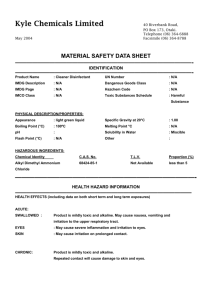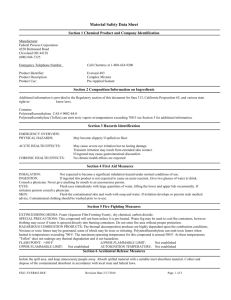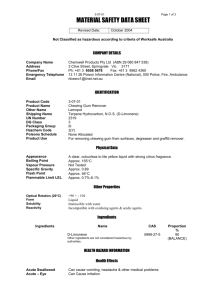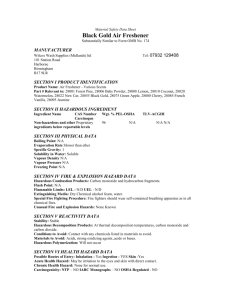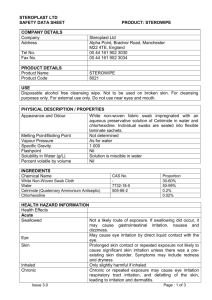Benedict Qualitative Solution Safety Data Sheet
advertisement
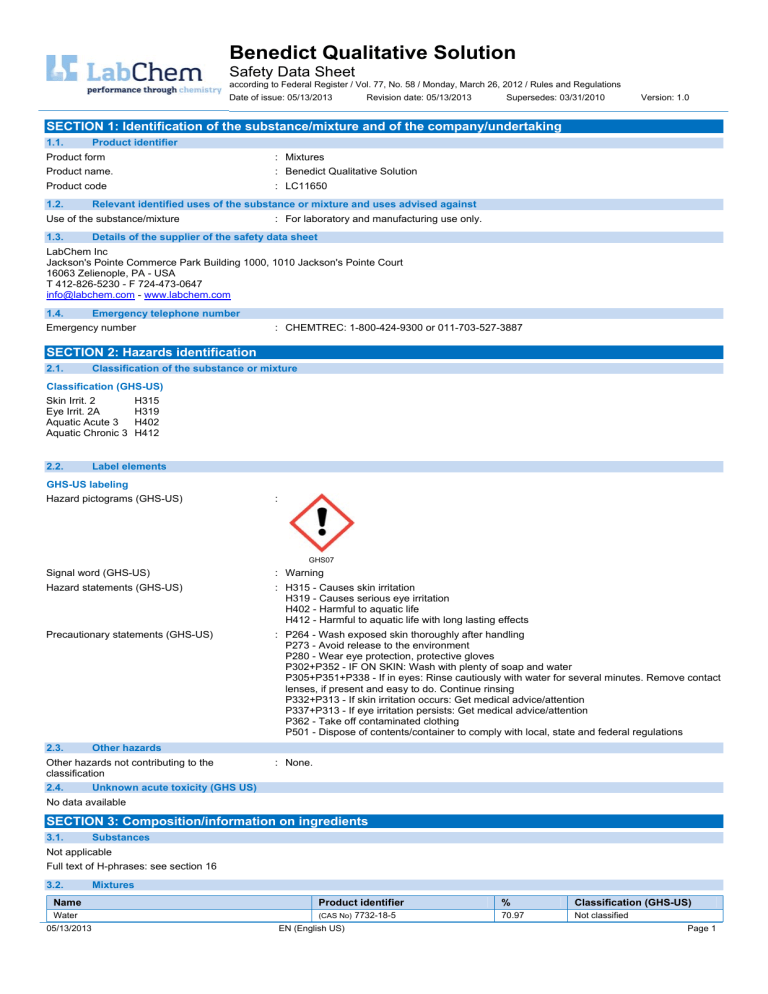
Benedict Qualitative Solution Safety Data Sheet according to Federal Register / Vol. 77, No. 58 / Monday, March 26, 2012 / Rules and Regulations Date of issue: 05/13/2013 Revision date: 05/13/2013 Supersedes: 03/31/2010 Version: 1.0 SECTION 1: Identification of the substance/mixture and of the company/undertaking 1.1. Product identifier Product form : Mixtures Product name. : Benedict Qualitative Solution Product code : LC11650 1.2. Relevant identified uses of the substance or mixture and uses advised against Use of the substance/mixture 1.3. : For laboratory and manufacturing use only. Details of the supplier of the safety data sheet LabChem Inc Jackson's Pointe Commerce Park Building 1000, 1010 Jackson's Pointe Court 16063 Zelienople, PA - USA T 412-826-5230 - F 724-473-0647 info@labchem.com - www.labchem.com 1.4. Emergency telephone number Emergency number : CHEMTREC: 1-800-424-9300 or 011-703-527-3887 SECTION 2: Hazards identification 2.1. Classification of the substance or mixture Classification (GHS-US) Skin Irrit. 2 Eye Irrit. 2A Aquatic Acute 3 Aquatic Chronic 3 2.2. H315 H319 H402 H412 Label elements GHS-US labeling Hazard pictograms (GHS-US) : Signal word (GHS-US) : Warning Hazard statements (GHS-US) : H315 - Causes skin irritation H319 - Causes serious eye irritation H402 - Harmful to aquatic life H412 - Harmful to aquatic life with long lasting effects Precautionary statements (GHS-US) : P264 - Wash exposed skin thoroughly after handling P273 - Avoid release to the environment P280 - Wear eye protection, protective gloves P302+P352 - IF ON SKIN: Wash with plenty of soap and water P305+P351+P338 - If in eyes: Rinse cautiously with water for several minutes. Remove contact lenses, if present and easy to do. Continue rinsing P332+P313 - If skin irritation occurs: Get medical advice/attention P337+P313 - If eye irritation persists: Get medical advice/attention P362 - Take off contaminated clothing P501 - Dispose of contents/container to comply with local, state and federal regulations GHS07 2.3. Other hazards Other hazards not contributing to the classification 2.4. : None. Unknown acute toxicity (GHS US) No data available SECTION 3: Composition/information on ingredients 3.1. Substances Not applicable Full text of H-phrases: see section 16 3.2. Mixtures Name Product identifier % Classification (GHS-US) Water (CAS No) 7732-18-5 70.97 Not classified 05/13/2013 EN (English US) Page 1 Benedict Qualitative Solution Safety Data Sheet according to Federal Register / Vol. 77, No. 58 / Monday, March 26, 2012 / Rules and Regulations Name Product identifier % Classification (GHS-US) Sodium Citrate Dihydrate (CAS No) 6132-04-3 17.3 Not classified Sodium Carbonate Anhydrous (CAS No) 497-19-8 10 Skin Irrit. 2, H315 Eye Irrit. 2A, H319 Copper(II) sulfate, pentahydrate (CAS No) 7758-99-8 1.73 Acute Tox. 3 (Oral), H301 Aquatic Acute 1, H400 Aquatic Chronic 1, H410 SECTION 4: First aid measures 4.1. Description of first aid measures First-aid measures general : Never give anything by mouth to an unconscious person. If you feel unwell, seek medical advice (show the label where possible). First-aid measures after inhalation : Assure fresh air breathing. Allow the victim to rest. First-aid measures after skin contact : Wash with plenty of soap and water. Wash contaminated clothing before reuse. If skin irritation occurs: Get medical advice/attention. First-aid measures after eye contact : Rinse immediately with plenty of water. Obtain medical attention if pain, blinking or redness persist. First-aid measures after ingestion : Rinse mouth. Do NOT induce vomiting. Obtain emergency medical attention. 4.2. Most important symptoms and effects, both acute and delayed Symptoms/injuries after inhalation : Coughing. Symptoms/injuries after skin contact : Causes skin irritation. Symptoms/injuries after eye contact : Causes serious eye irritation. Symptoms/injuries after ingestion : Nausea. Vomiting. Low arterial pressure. Enlargement/affection of the liver. Chronic symptoms : Dry skin. Possible inflammation of the respiratory tract. 4.3. Indication of any immediate medical attention and special treatment needed None. SECTION 5: Firefighting measures 5.1. Extinguishing media suitable extinguishing media : Foam. Dry powder. Carbon dioxide. Water spray. Sand. Unsuitable extinguishing media : Do not use a heavy water stream. 5.2. Special hazards arising from the substance or mixture Fire hazard : Not flammable. Explosion hazard : Not applicable. Reactivity : None. 5.3. Advice for firefighters Firefighting instructions : Use water spray or fog for cooling exposed containers. Exercise caution when fighting any chemical fire. Avoid (reject) fire-fighting water to enter environment. Protection during firefighting : Do not enter fire area without proper protective equipment, including respiratory protection. Other information : Not applicable. SECTION 6: Accidental release measures 6.1. Personal precautions, protective equipment and emergency procedures General measures 6.1.1. For non-emergency personnel Emergency procedures 6.1.2. : Isolate from fire, if possible, without unnecessary risk. : Evacuate unnecessary personnel. For emergency responders Protective equipment : Equip cleanup crew with proper protection. Emergency procedures : Ventilate area. 6.2. Environmental precautions Prevent entry to sewers and public waters. Notify authorities if liquid enters sewers or public waters. Avoid release to the environment. 6.3. Methods and material for containment and cleaning up Methods for cleaning up 6.4. : Soak up spills with inert solids, such as clay or diatomaceous earth as soon as possible. Collect spillage. Store away from other materials. Reference to other sections See Heading 8. Exposure controls and personal protection. 05/13/2013 EN (English US) 2/7 Benedict Qualitative Solution Safety Data Sheet according to Federal Register / Vol. 77, No. 58 / Monday, March 26, 2012 / Rules and Regulations SECTION 7: Handling and storage 7.1. Precautions for safe handling Precautions for safe handling : Wash hands and other exposed areas with mild soap and water before eating, drinking or smoking and when leaving work. Provide good ventilation in process area to prevent formation of vapor. Hygiene measures : Wash exposed skin thoroughly after handling. 7.2. Conditions for safe storage, including any incompatibilities Storage conditions : Keep only in the original container in a cool, well ventilated place away from : incompatible materials. Keep container closed when not in use. Incompatible products : Strong bases. strong acids. Incompatible materials : Sources of ignition. Direct sunlight. 7.3. Specific end use(s) No additional information available SECTION 8: Exposure controls/personal protection 8.1. Control parameters 8.2. Exposure controls Appropriate engineering controls : Emergency eye wash fountains and safety showers should be available in the immediate vicinity of any potential exposure. Personal protective equipment : Avoid all unnecessary exposure. Hand protection : Wear protective gloves. Eye protection : Chemical goggles or safety glasses. Skin and body protection : Wear suitable protective clothing. Respiratory protection : Wear appropriate mask. Consumer exposure controls : Avoid contact during pregnancy/while nursing. Other information : Do not eat, drink or smoke during use. SECTION 9: Physical and chemical properties 9.1. Information on basic physical and chemical properties Physical state : Liquid Color : Blue. Odor : odorless. Odor threshold : No data available pH : 9 - 11 (25°C) Relative evaporation rate (butyl acetate=1) : No data available Melting point : No data available Freezing point : No data available Boiling point : No data available Flash point : No data available Self ignition temperature : No data available Decomposition temperature : No data available Flammability (solid, gas) : No data available Vapor pressure : No data available Relative vapor density at 20 °C : No data available Relative density : No data available Solubility : No data available Log Pow : No data available Log Kow : No data available Viscosity, kinematic : No data available Viscosity, dynamic : No data available Explosive properties : No data available. Oxidizing properties : No data available. Explosive limits : No data available 9.2. Other information No additional information available 05/13/2013 EN (English US) 3/7 Benedict Qualitative Solution Safety Data Sheet according to Federal Register / Vol. 77, No. 58 / Monday, March 26, 2012 / Rules and Regulations SECTION 10: Stability and reactivity 10.1. Reactivity None. 10.2. Chemical stability Not established. 10.3. Possibility of hazardous reactions Not established. 10.4. Conditions to avoid Direct sunlight. Extremely high or low temperatures. 10.5. Incompatible materials strong acids. Strong bases. 10.6. Hazardous decomposition products fume. Carbon monoxide. Carbon dioxide. SECTION 11: Toxicological information 11.1. Information on toxicological effects Acute toxicity : Not classified Sodium Citrate Dihydrate (6132-04-3) LD50 oral rat 6730 mg/kg Sodium Carbonate Anhydrous (497-19-8) LD50 oral rat 4090 mg/kg Water (7732-18-5) LD50 oral rat ≥ 90000 mg/kg Copper(II) sulfate, pentahydrate (7758-99-8) LD50 oral rat LD50 dermal rabbit 300 mg/kg (Rat) > 2000 mg/kg (Rabbit) Skin corrosion/irritation : Causes skin irritation. Serious eye damage/irritation : Causes serious eye irritation. Respiratory or skin sensitization : Not classified Germ cell mutagenicity : Not classifiedBased on available data, the classification criteria are not met pH: 9 - 11 (25°C) pH: 9 - 11 (25°C) Carcinogenicity : Not classified Reproductive toxicity : Not classifiedBased on available data, the classification criteria are not met Specific target organ toxicity (single exposure) : Not classified Specific target organ toxicity (repeated exposure) : Not classifiedBased on available data, the classification criteria are not met Aspiration hazard : Not classifiedBased on available data, the classification criteria are not met Potential Adverse human health effects and symptoms : Based on available data, the classification criteria are not met. Symptoms/injuries after inhalation : Coughing. Symptoms/injuries after skin contact : Causes skin irritation. Symptoms/injuries after eye contact : Causes serious eye irritation. Symptoms/injuries after ingestion : Nausea. Vomiting. Low arterial pressure. Enlargement/affection of the liver. Chronic symptoms : Dry skin. Possible inflammation of the respiratory tract. SECTION 12: Ecological information 12.1. Toxicity Ecology - water : Harmful to aquatic life with long lasting effects. Benedict Qualitative Solution EC50 Daphnia 1 13.8 mg/l Sodium Citrate Dihydrate (6132-04-3) EC50 Daphnia 1 655 - 825.9 mg/l 05/13/2013 EN (English US) 4/7 Benedict Qualitative Solution Safety Data Sheet according to Federal Register / Vol. 77, No. 58 / Monday, March 26, 2012 / Rules and Regulations Sodium Carbonate Anhydrous (497-19-8) LC50 fish 1 EC50 Daphnia 1 LC50 fish 2 300 mg/l 265 mg/l 740 mg/l Copper(II) sulfate, pentahydrate (7758-99-8) LC50 fish 1 LC50 fish 2 TLM fish 1 1.5 mg/l (24 h; Lepomis macrochirus; TOXICITY TEST) 0.17 mg/l 24 h; Salmo gairdneri (Oncorhynchus mykiss) 3.8 ppm (24 h; Salmo gairdneri (Oncorhynchus mykiss); Fresh water) 12.2. Persistence and degradability Benedict Qualitative Solution Persistence and degradability May cause long-term adverse effects in the environment. Sodium Carbonate Anhydrous (497-19-8) Persistence and degradability Not established. Copper(II) sulfate, pentahydrate (7758-99-8) Persistence and degradability Biochemical oxygen demand (BOD) Chemical oxygen demand (COD) ThOD BOD (% of ThOD) Not established. Not applicable Not applicable Not applicable Not applicable 12.3. Bioaccumulative potential Benedict Qualitative Solution Bioaccumulative potential Not established. Sodium Carbonate Anhydrous (497-19-8) Bioaccumulative potential Not established. Copper(II) sulfate, pentahydrate (7758-99-8) Bioaccumulative potential Bioaccumable. Not established. 12.4. Mobility in soil Copper(II) sulfate, pentahydrate (7758-99-8) Ecology - soil 12.5. Toxic to flora. Other adverse effects Other information : Avoid release to the environment. SECTION 13: Disposal considerations 13.1. Waste treatment methods Waste disposal recommendations : Dispose in a safe manner in accordance with local/national regulations. Dispose of contents/container to comply with local, state and federal regulations. Ecology - waste materials : Avoid release to the environment. SECTION 14: Transport information In accordance with ADR / RID / ADNR / IMDG / ICAO / IATA 14.1. UN number Not applicable 14.2. UN proper shipping name Not applicable 14.3. Additional information Other information : No supplementary information available. Overland transport No additional information available Transport by sea No additional information available Air transport No additional information available 05/13/2013 EN (English US) 5/7 Benedict Qualitative Solution Safety Data Sheet according to Federal Register / Vol. 77, No. 58 / Monday, March 26, 2012 / Rules and Regulations SECTION 15: Regulatory information 15.1. US Federal regulations Benedict Qualitative Solution Listed on the United States TSCA (Toxic Substances Control Act) inventory Sodium Carbonate Anhydrous (497-19-8) Listed on the United States TSCA (Toxic Substances Control Act) inventory Copper(II) sulfate, pentahydrate (7758-99-8) Listed on the United States TSCA (Toxic Substances Control Act) inventory Listed on SARA Section 313 (Specific toxic chemical listings) RQ (Reportable quantity, section 304 of EPA's 10 lb List of Lists) : 15.2. International regulations CANADA Benedict Qualitative Solution Listed on the Canadian DSL (Domestic Substances List) inventory. WHMIS Classification Class D Division 2 Subdivision B - Toxic material causing other toxic effects Sodium Carbonate Anhydrous (497-19-8) Listed on the Canadian DSL (Domestic Substances List) inventory. WHMIS Classification Class D Division 2 Subdivision B - Toxic material causing other toxic effects Copper(II) sulfate, pentahydrate (7758-99-8) Listed on the Canadian DSL (Domestic Substances List) inventory. WHMIS Classification Class D Division 1 Subdivision B - Toxic material causing immediate and serious toxic effects EU-Regulations No additional information available Classification according to Regulation (EC) No. 1272/2008 [CLP] Classification according to Directive 67/548/EEC or 1999/45/EC Not classified 15.2.2. National regulations Benedict Qualitative Solution Listed on the Canadian Ingredient Disclosure List Sodium Carbonate Anhydrous (497-19-8) Listed on the Canadian Ingredient Disclosure List Copper(II) sulfate, pentahydrate (7758-99-8) Listed on the Canadian Ingredient Disclosure List 15.3. US State regulations Copper(II) sulfate, pentahydrate (7758-99-8) U.S. - California - Priority Toxic Pollutants - Freshwater Criteria SECTION 16: Other information Indication of changes : Revision - See : *. Other information : None. Full text of H-phrases: see section 16: -----Acute Tox. 3 (Oral) -----Aquatic Acute 1 -----Aquatic Acute 3 -----Aquatic Chronic 1 05/13/2013 Acute toxicity (oral) Category 3 Hazardous to the aquatic environment - Acute Hazard Category 1 Hazardous to the aquatic environment - Acute Hazard Category 3 Hazardous to the aquatic environment - Chronic Hazard Category 1 EN (English US) 6/7 Benedict Qualitative Solution Safety Data Sheet according to Federal Register / Vol. 77, No. 58 / Monday, March 26, 2012 / Rules and Regulations ---------------------------------------------- Aquatic Chronic 3 Eye Irrit. 2A Skin Irrit. 2 H301 H315 H319 H400 H410 H412 Hazardous to the aquatic environment - Chronic Hazard Category 3 Serious eye damage/eye irritation Category 2A skin corrosion/irritation Category 2 Toxic if swallowed Causes skin irritation Causes serious eye irritation Very toxic to aquatic life Very toxic to aquatic life with long lasting effects Harmful to aquatic life with long lasting effects NFPA health hazard : 1 - Exposure could cause irritation but only minor residual injury even if no treatment is given. NFPA fire hazard : 0 - Materials that will not burn. NFPA reactivity : 0 - Normally stable, even under fire exposure conditions, and are not reactive with water. HMIS III Rating Health : 1 Slight Hazard - Irritation or minor reversible injury possible Flammability : 0 Minimal Hazard Physical : 0 Minimal Hazard Personal Protection : B SDS US (GHS HazCom 2012) Information in this SDS is from available published sources and is believed to be accurate. No warranty, express or implied, is made and LabChem Inc assumes no liability resulting from the use of this SDS. The user must determine suitability of this information for his application. 05/13/2013 EN (English US) 7/7
